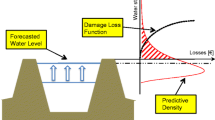Abstract
Avalanche forecasting has traditionally been defined from the perspective of a geophysical problem with respect to the state of stability of the snow cover. In thistwo-part treatise, avalanche forecasting is described in a broader sense by dividing it into seven inter-connected elements: I. definition; II. goal; III. human factors and perception; IV. reasoning process; V. information types and informational entropy; VI. scales in space and time; and VII. decision-making. Part I (this paper), contains the first four elements which are mostly about the human issues and Part II (the following paper) contains the last three elements, which are mostly about the physical issues, and some basic Rules of applied avalanche forecasting. A principal thesis is that all seven elements must be mastered for optimal avalanche forecasting. In addition to the seven elements, the connection to avalanche forecasting as an exercise in risk analysis is made. Inherent in the argument is that avalanche forecasting is a dynamic problem dealing with variations and interaction of a human (avalanche forecaster) and natural system (temporal and spatially varying state of instability of the snow cover). The primary result of the two papers is a first attempt to formally integrate human influences with a new interpretation of the geophysical problem. Since most avalanche accidents result from human errors, no description of avalanche forecasting is complete unless the human component is addressed.
Similar content being viewed by others
References
Adams, J.: 1995, Risk, University College London, London, 228 pp.
Bader, H. P. and Salm, B.: 1990, On the mechanics of snow slab failure. Cold Regions Sci.and Tech. 17(3), 287-300.
Bažant, Z. P. and Planas, J.: 1998, Fracture and Size Effect in Concrete and Other Quasibrittle Materials, CRC Press, Boca Raton, FL, pp. 616.
Bruns, W.: 1997, Snow science and safety for the mountain guide. International Snow Science Workshop 1996, Canadian Avalanche Association, Revelstoke, BC, 203-206.
Buser, O., Bütler, M., and Good, W.: 1987, Avalanche forecast by the nearest neighbour method, IAHS Publ. 162, 557-569.
Dennis, A. and Moore, M.: 1997, Evolution of public avalanche information: the North American experience with danger rating levels. In: Proc.International Snow Science Workshop 1996, Canadian Avalanche Association, Revelstoke, B.C., Canada, 60-66.
Föhn, P. M. B.: 1989. Snowcover stability tests and areal variability of snow strength. In: Proceedings of the International Snow Science Workshop, October 12-15, 1988, Whistler, B.C., Canada. Canadian Avalanche Association, Vancouver, B.C., 262-273.
Fredston, J. and Fesler, D.: 1994, Snow Sense, Alaska Mountain Safety Center, Inc., Anchorage, AK, 115 pp.
Haegeli, P. and McClung, D. M.: 2001, A new perspective on computer-aided avalanche forecasting: scale and scale issues. In: Proceedings: International Snow Science Workshop, Bozeman, Montana, October 2-6, 2000, 66-73.
Jamieson, J. B. and Johnston, C. D.: 1992, Snowpack characteristics associated with avalanche accidents, Can.Geotech.Journ. 29, 862-866.
Keylock, C., McClung, D., and Magnússon, M. M.: 1999. Avalanche risk mapping by simulation, J.Glaciol. 45(150), 303-314.
LaChapelle, E. R.: 1980, The fundamental processes in conventional avalanche forecasting, J.Glaciol. 26(94), 75-84.
Lee, K. N.: 1993, Compass and Gyroscope, Island Press, Washington, D.C., 244 pp.
Makridakis, S. G.: 1990, Forecasting, Planning and Strategy for the 21st Century, The Free Press, New York, 293 pp.
McClung, D. M.: 1979, Shear fracture precipitated by strain-softening as a mechanism of dry slab avalanche release, J.Geophys.Res. 84(B7), 3519-3526.
McClung, D. M.: 1981, Fracture mechanical models of dry slab avalanche release, J.Geophys.Res. 86(B11), 10783-10790.
McClung, D. M.: 1987. Mechanics of snow slab failure from a geotechnical perspective, IASH Publ. 162, 475-508.
McClung, D. M.: 1995, Expert knowledge in avalanche forecasting, Defence Science Journal 45(2), 117-123.
McClung, D. M.: 1996. Effects of temperature on fracture in dry slab avalanche release, J.Geophys.Res. 101(B10), 21907-21920.
McClung, D. M.: 2000, Predictions in avalanche forecasting, Ann.Glaciol. 31, 377-381.
McClung, D. M.: 2001, The elements of applied avalanche forecasting. Part II: the physical issues and the rules of applied avalanche forecasting, Natural Hazards 26, 131-146.
McClung, D. M. and Tweedy, J.: 1994, Numerical avalanche prediction: Kootenay Pass, British Columbia, J.Glaciol. 40(135), 350-358.
McClung, D. and Schaerer, P.: 1993, The Avalanche Handbook, The Mountaineers, Seattle, pp. 271.
McClung, D. M. and Schweizer, J.: 1999. Skier triggering, snow temperatures and the stability index for dry slab avalanche initiation, J.Glaciol. 45(150), 190-200.
Pearl, J.: 1988, Probabilistic Reasoning in Intelligent Systems: Networks of Plausible Inference, Morgan Kaufmann Publishers, San Mateo, CA, 522 pp.
Press, S. J.: 1989, Bayesian Statistics: Principles, Models and Applications, John Wiley & Sons. New York, 237 pp.
Schweizer, J.: 1998, Laboratory experiments on shear failure of snow, Ann.Glaciol. 26, 97-102.
Schweizer, J. and Föhn, P. M. B.: 1996, Avalanche forecasting-an expert system approach, J.Glaciol. 42(141), 318-332.
White, G. F. (ed.): 1974, Natural Hazards: Local, National, Global, Oxford University Press, Oxford, UK.
Wilde, G. J. S.: 1994, Target Risk, PDE Publications, Toronto, 234 pp.
Author information
Authors and Affiliations
Rights and permissions
About this article
Cite this article
McClung, D.M. The Elements of Applied Avalanche Forecasting, Part I: The Human Issues. Natural Hazards 26, 111–129 (2002). https://doi.org/10.1023/A:1015665432221
Issue Date:
DOI: https://doi.org/10.1023/A:1015665432221




